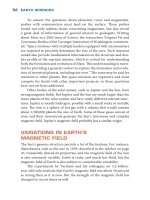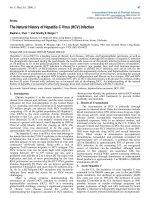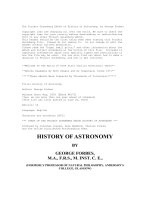Earth history
Bạn đang xem bản rút gọn của tài liệu. Xem và tải ngay bản đầy đủ của tài liệu tại đây (2.49 MB, 60 trang )
Earth’s History
1
Earth’s History
• Planet Earth is approximately
9
4.5 X 10 years old
–Rocks of the crust provide clues to
Earth’s past
• By analyzing these clues we can
infer events from the past
2
Earth’s History
• Principle of Uniformitarianism
– Major assumption in geology
– Events in the past occurred the same
way that they are occurring today.
Examples Include:
• Weathering/erosion
• Deposition
• Volcanism
• Plate tectonics
3
Geologic Time
• Plate motions
and mountain
building events
can be placed
on the geologic
time scale
4
Geologic
Time
Geologists
have divided
Earth’s history
into time units
based on the
the fossil record
5
Geologic Time
• A study of the fossil record shows
– A great variety of plants, animals, and
simpler life forms have lived on Earth in
the past
– That life forms have evolved through
time
– Most life forms of the geologic past have
become extinct
6
7
Geologic Dating
8
There are two types of
Geologic Dating
• Absolute
–Determines how many years old
something is
• Relative
–Used to determine if one thing is
younger or older than another
9
Tools used to determine
Absolute Age
• Using radiometric
dating
Relative Age
• Law of superposition
• Use of index fossils
• Correlation of rock
layers
10
Relative Dating
11
Law of Superposition
• Sediments are laid down
underwater in horizontal layers
and form sedimentary rocks
12
Law of Superposition
• In a series of sedimentary rocks the
bottom layer is the oldest and the top
layer is the youngest
– Lower layers must be in place before
younger rocks can be deposited on top of
them
– Exception: when something occurs to
overturn layers
13
Grand Canyon
14
GRAND CANYON- LAW OF SUPERPOSITION
YOUNGEST ON TOP
OLDEST ON BOTTOM
Law of Superposition
• Rock layers are older than folds found in them
– Layers were there before they were folded
16
Folds/Tilted
17
Law of Superposition
• Rock layers are older than
faults found in them
• This is logical: you can’t break a
rock if it does not exist; so rock
containing a fault must be older
than the fault
18
Law of Superposition
• Fossils are generally the same
age as the rock layers in which
they are found
– Animal remains are deposited
along with the sediments that will
turn into sedimentary rocks
19
Law of Superposition
• Igneous intrusions are younger than the
rock that they cut through or flow out of
20
Igneous Intrusion - Cross
Cutting
21
Unconformity
• When a new rock layer is formed
atop an eroded surface
22
23
Upper Silurian
Carbonates
Tilted
Ordovician
Shales and
Sandstones
unconformity
Taconic Unconformity
24
Practice: what happened here?
25









